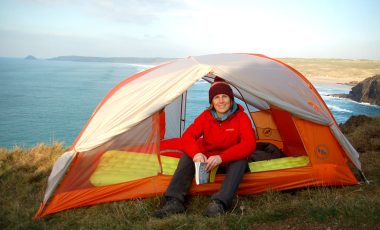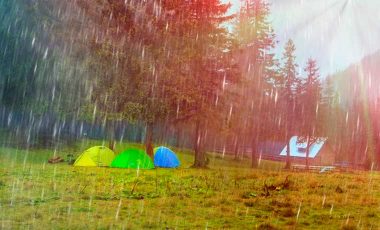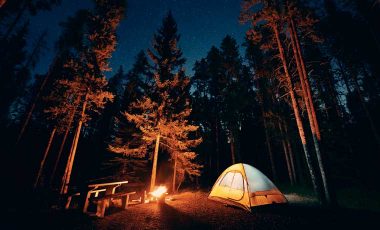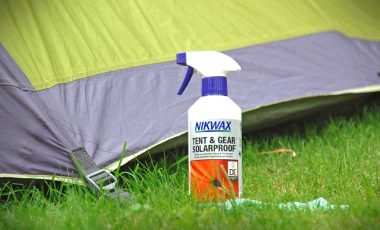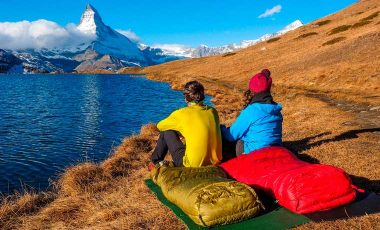New to camping and don’t want to spend hours putting up your new or borrowed tent? Yes, it really can take that long if you don’t know what you’re doing! So you need to learn the basics of how to set up a tent before you get to your campground. Although if you’re wanting to make some friends then rocking up completely clueless is a sure-fire way to get some attention from your neighbouring campers. They’ll be more than happy to share their ‘extensive’ knowledge on tent pitching – not always the most reliable option!
So take a read of our guide on how to set up a tent step by step, to make sure putting it up is the easiest part of your camping weekend.
Not only will you learn the basics on how to set up a tent, you’ll also get some super helpful tips and gems of wisdom on where to pitch your tent, and where not to! Believe me, setting up your tent in the wrong spot can ruin your camping experience. So if you are new to camping or just looking for a little advice, then skip straight to our tips on how to set up a tent in the perfect spot.
How to set up a tent
Before we go any further, you must remember that nearly all tents are different. Even the same style of tent will be different from brand to brand. So we’re going to focus on modern tents: tents with a fly sheet, an inner compartment, and poles that bend to form a tunnel or dome-like structure. If you’re looking for instructions on how to set up an old canvas scout tent, or a huge marquee-style tent, then this may not be for you, so skip to the useful tips on finding the best place to set up a tent.
Once you’ve found the best possible place to set up your tent, roll your sleeves up and go for it!
Unpack your tent
Make sure you do this with care and don’t just chuck it on the ground. Small components of the tent can easily get lost or damaged. Also, if it is windy then be sure to place something on the tent bag and tent fly to stop them from blowing away
Separate the parts
Next up you need to identify which part is the fly (outer rain cover) and which is the inner part of the tent. Get your tent pegs/stakes out of the bag and at the ready, and take out the poles.

Connect your poles
The poles of your tent will be linked internally with a stretchy string to enable them to fold up when not in use. Connect all the sections of the poles together and lay them out so you can see which is which – some are colour-coded to help you identify them more easily, or they might be different lengths.
Place a tent footprint or groundsheet down
Some tent floors are a little on the thin side, so placing a footprint or groundsheet down beneath the tent will protect you and your tent from the rough ground and also provide a floor for your tent vestibule, if there isn’t one built in.
Connect the poles to the tent
There are two ways of doing this, depending on your tent. Some tunnel or dome tents have poles that connect to the outer fly first and then the inner is clipped inside afterwards.
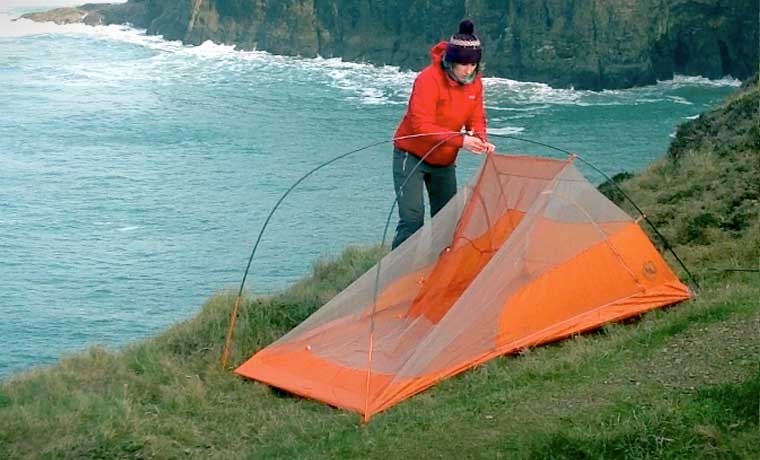
In this description the tent poles connect to the inner tent first:
Lay the inner tent out on the ground
- Identify the correct place for each pole (you may need to refer to the tent instructions for this, otherwise look for colour-coded poles and pole attachments on the tent).
- Place the ends of the poles into the pole attachments, bending the poles to fit between them.
- Once all pole ends are attached to the tent, clip the sides and top of the inner tent onto the poles.
Some tents have sleeves for the poles to slide through, instead of clips. If this is the case then slide the poles through the sleeves before securing the pole ends into the tent attachments at the base of the tent. There may also be an attached tie at the peak of the tent to secure the ceiling to the top of the poles with a simple bow.
Stake out the corners
Firstly make sure the doors of your tent are facing the right way – if not then turn the tent and the groundsheet to the correct position.
Secure the four corners of your tent to the ground with a peg or stake. Be sure to eliminate any slack in the tent by pulling the corners away from each other before placing the stake.
Push the stakes into the ground at a 45º angle leaning away from the tent and make sure that they are as far into the ground as possible. (But not buried!)
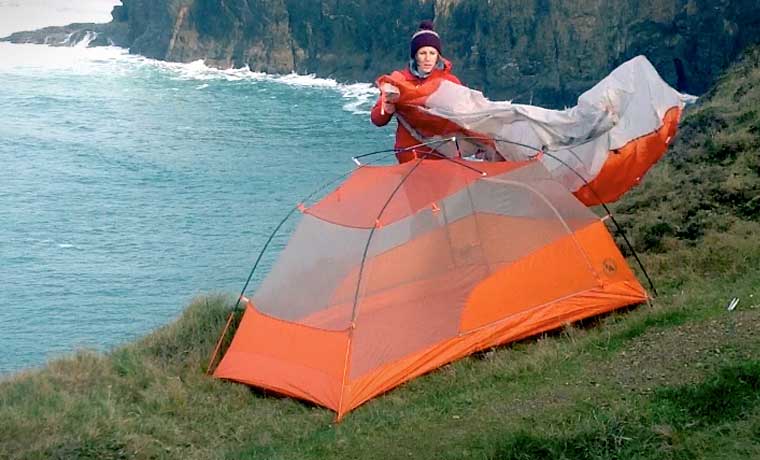
Attached the outer fly
Place the fly over the top of the tent frame, making sure that the door to the outer fly corresponds with the door to the inner tent.
Secure the fly to the poles using the loops/tabs on the inside of the fly, and attach the bottom corners of the fly either to an attachment at the bottom of each pole, or secure to the ground with stakes.
Stake out the rest of the tent
Once the fly is positioned correctly on top of the tent poles and inner tent, make sure the doors of the fly are zipped closed. Then you can stake out the rest of the loops on the bottom of the fly by gently drawing the fly away from the inner and creating tension between each stake.
It’s important that the tension across the whole of the fly is even. This prevents the tent fly from flapping or touching the inner tent, and ensures that the inner is totally protected from the elements.

Secure the guylines
Lastly, you will need to secure the guylines of your tent either to the ground using tent stakes, or to nearby trees or rocks. The guylines should create further tension across the tent to increase the stability of the tent in high winds. They also ensure that the tent fly is kept away from the tent inner – this is important to keep airflow in the tent and to stop rain or condensation dripping through to the inside of the tent.
7 Simple tips on how to set up a tent in the perfect spot
1Practise at home first
This is a must and will save you hours of embarrassing struggle at the campground. It is also an essential exercise in making sure all the parts of your tent are there and correct. Even brand new tents can come with things missing or the wrong components.
Checking your new tent may seem like an unnecessary precaution but it really is a must. On an hiking trip in Iceland a few years ago, my friends pitched their brand new tent for the first time on the night we arrived in the country. Unfortunately they soon discovered that the poles were the wrong size for the tent, and so it was rendered useless. Thankfully it was the night before we set off into the wilderness for 5 days, so they were able to go and buy a whole new tent (with a very steep Icelandic price tag!). Don’t make the same mistake!
2Arrive to the campground early
This greatly increases your choice of the best camping spots and also ensures that you don’t have to put the tent up in the dark.
3Choose the best camping spot on the campground
Take your time to look at all your options before you make a decision. This is your temporary home for a few days so don’t settle for anything but the best that’s available. Consider the following when looking for the best camping pitch:
The toilets – Avoid camping right next to the toilet block, but also don’t go too far from it. This may depend on how much you tend to visit the bathroom in the night. If never, then go further away to avoid being disturbed by others walking past your tent to get there. If frequently then stay a little closer for convenience.
- The view – If you plan on hanging out at camp during the day then having a great view will make it all the nicer. Pitches on the edge of the campground usually provide more to look at than just your neighbours’ tents.
- Water supply – Filling up water containers and bottles is so much easier if you are not too far from a water supply. However if you are in mosquito season, this might not be as appealing.
- Traffic – It may sound silly, but campgrounds have main ‘roads’ in them. And although the average speed of the traffic is probably well below 10 mph, to get the most tranquil setting possible, opt for a camping spot off one of the smaller roads.
4Scope out your potential neighbours
As you explore the campground in search of the perfect spot, discreetly take note of the people nearby. If you’re hoping for a sleep in during the mornings, then maybe avoid being close to the family with young kids! Likewise, if you are planning to stay up late around the campfire then distance yourself from the families and allow them some sleep.
5Assess the sun
Take a moment to note how much sun your camping spot is likely to get and at what times of the day. This depends on the time of year, the climate and your preferences. Will the heat and light of the sun wake you up when it rises at 5am? Or will you be shivering in the shade by 4pm in the afternoon?
6Assess the weather
Never expect the weather to be perfect. Even when the forecast is looking glorious, plan for unexpected changes. So if possible, consider which way the wind is blowing and pitch your tent so that the strongest part is face on into the wind. Make sure there is space to stake out your guy lines and if possible, pitch your tent next to some natural shelter like a hedge or undergrowth, or lower on a slope. You can even park your car close to your tent to provide some extra protection if needed.
7Check out the ground
One of the most important things when choosing the perfect camping spot for your tent is the ground that you intend sleeping on. You can have the best view and the quietest spot ever, but if you are sleeping on uneven ground then none of that will matter. So make sure the ground is not only as flat as possible, but is also free from rocks or tree routes that will make sleeping an unenjoyable event.
The more you camp, the more you will realise why finding the perfect camping spot is so important and what you love the most. And once you know how to set up a tent with confidence, you can spend more time choosing perfection in your camping spot and less time worrying about your tent blowing away in the middle of the night!
Enjoy setting up your tents happy campers!


